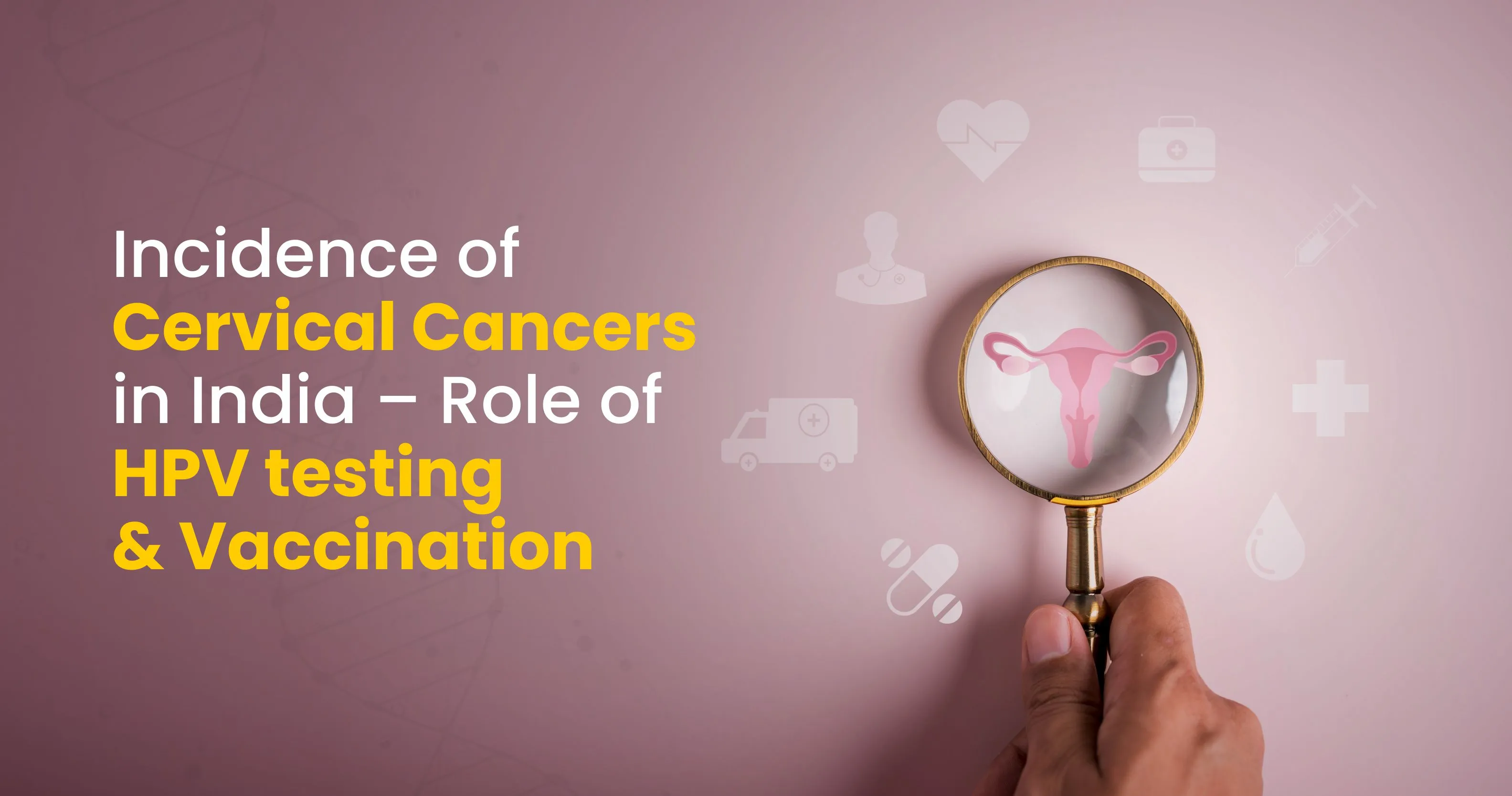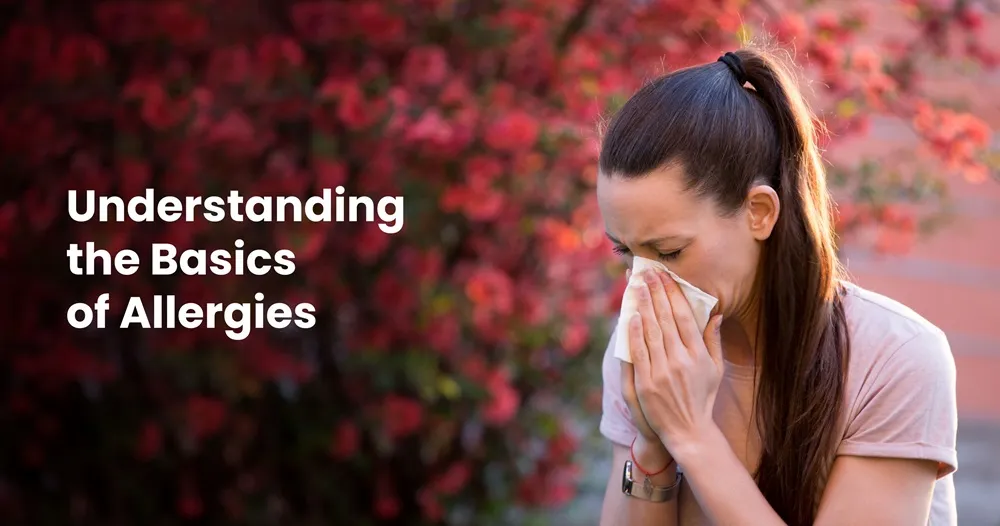Incidence of Cervical Cancers in India – Role of HPV testing & Vaccination
Sep 23, 2023

Cervical cancer is the most prevalent cancer in women in India. About 365.71 million women over age 15 live in India and are at risk of developing cervical cancer. According to the most recent estimates, India accounts for roughly one-third of all cervical cancer deaths worldwide, with 132,000 newly diagnosed cases and 74,000 fatalities yearly. It is estimated that 6.6 per cent of women in the general population currently have cervical HPV infection. Nearly 76.7% of cervical cancer in India is caused due HPV serotypes 16 and 18.
Cancer that starts in the cells of the cervix is called cervical cancer and the cervix is the lower, more constricted end of the Uterus or womb. As a result, an HPV Screening test and vaccine has generated considerable excitement and controversy.
Understanding Cervical Cancer and its Relation with Human Papillomavirus (HPV)
Cervical cancer is a condition in which the cervical cells proliferate uncontrollably. Cervical cancer is mostly related to the HPV (human papillomavirus), the most prevalent sexually transmitted infection. More than 40 HPV types can affect both men and women's genital regions, including the skin of the penis, vulva, and anus, as well as the vagina, cervix, and rectum linings.
According to whether HPV virus increases a person's risk of developing cancer, HPV types are frequently classified as "non-oncogenic" or "oncogenic." According to the International Agency for Research on Cancer, 13 different HPV strains have been linked to cervical cancer, and at least one has been linked to cervix cancer.
How HPV Infection Can Cause Cancer - Global Statistics
An HPV infection caused by oncogenic HPV types can linger for a long time and eventually transform healthy cells into cancerous cells if the body's immune system eradicates it. A long-lasting HPV infection that increases the risk of cervical cancer occurs in 10% to 15% of women with cervix-based HPV infections. If not discovered and removed promptly, they might eventually become cancer.
With an anticipated 604,000 new cases and 342,000 fatalities in 2020, cervical cancer will rank as the fourth most common cancer among women worldwide. Around 90% of new cases and fatalities worldwide in 2020 are mainly in low- and middle-income nations. Human papillomavirus (HPV) infection is associated with almost all cases of cervical cancer (99%) and is a common virus spread through sexual contact.
HPV Screening Test
The human papillomavirus (HPV), a virus that can cause genital warts, abnormal cervical cells, or cervical cancer, is found using the human papillomavirus (HPV) test. Your doctor's office will perform a combination Pap-HPV test in just a few minutes. Here is how an HPV screening test is performed:
- A vaginal speculum holds the vaginal walls apart during a Pap test to reveal the cervix.
- Next, cells from the
 cervix are taken using a tiny plastic spatula and cone-shaped brush.
cervix are taken using a tiny plastic spatula and cone-shaped brush. - The brush and spatula are rinsed in a vial of liquid before being sent to a lab for analysis.
HPV Vaccination
Moreover, there is a vaccine available to prevent the human papillomavirus (HPV) types that are responsible for the majority of cervical cancers. The HPV strains that most commonly result in genital warts are protected against with the help of a vaccine.
- For girls aged 11 and 12, HPV vaccination is advised.
- The HPV vaccine can be given to girls as young as nine years old, and it is also advised for women and girls aged 13 to 26 who haven't finished the series or gotten the vaccine yet.
- To protect against cancers brought on by HPV, the CDC advises 11 to 12-year-olds to receive two doses of the HPV vaccine.
Role of HPV Testing and Vaccination
To accelerate the elimination of cervical cancer, WHO launched the global Cervical Cancer Elimination Initiative in 2020. This initiative's goal is to lower incidence below a cutoff point of 4 cases per 100,000 women years in every country, which will help to reduce the disease's disparities globally. The initiative's 90-70-90 goal, which must be accomplished by 2030, calls for 90 per cent of girls to receive vaccinations by the age of 15, 70 per cent of women to undergo at least two high-performance test screenings by the age of 45, and 90 per cent of women with cervical precancer or cancer to receive treatment.
Risk Factors of Cervical Cancer
Numerous risk factors have been seen for acquiring an HPV infection and its subsequent progression to cervical carcinogenesis. The co-factors most likely to affect the risk of HPV and progressing from cervical HPV infection to:
- High-grade cervical precancers
- Long-term use of oral contraceptive pills
- Tobacco use
- Co-infection with other sexually transmitted agents is one of the common risk factors.
- Lifestyle factors may influence such as multiple sexual partners, younger age at first sexual encounter, and immunosuppression.
- Improper diet
When To See A Doctor For Cervical Cancer?
As per most recommendations, beginning routine cervical cancer screening at age 21 is essential due to the increase in cervical cancer cases due to HPV infection, as mentioned in Globocan Data. During these screening tests, a medical professional takes cells from the cervix to be examined in a lab for HPV Screening. Usually, there are no symptoms or signs of early-stage cervical cancer. Thus, it is required to book an appointment if any of any advanced cervical cancer symptoms and signs are seen, such as:
- Bleeding from the cervix following sex, in between periods, or following menopause.
- Bloody, watery, and foul-smelling vaginal discharge.
- Pain during sexual activity or in the pelvis.
Conclusion
Around the world, cervical cancer is caused due to a significant amount of morbidity and mortality. High-risk HPV strains are a well-known primary cause of cervical cancer, and this form of cancer can be avoided. Due to the absence of HPV screening and low public awareness of the issue, cervical cancer has a high incidence with a sizable mortality rate. The screening program is crucial due to cervical cancer's high incidence and mortality and vaccination is essential to avoid getting infected from HPV virus.
It's possible to both prevent and treat cervical cancer. Apollo Diagnostics can help you provide effective medical tests with a home collection service and provide results at the earliest. Book an appointment today for a screening test for HPV with compassionate care and advanced diagnostics.
Frequently Asked Questions
1. What causes cervical cancer?
Cervical cells can develop into cancer abnormally and uncontrollably over time. Invasion of the cervical tissue by cancer cells occurs at a deeper level. Advanced cancers have the potential to spread to the body's other organs.
2. How many months should pass between Pap smears?
Every three to five years, depending on age, Pap smear examinations start at age 21 and continue.
3. What is the HPV vaccine's age limit?
The HPV vaccine has most recently been expanded to cover all adults, male and female, up to age 45.
Related Blog Post
- 5 Ways to support a loved one with cancer
- Preventing cancer is better than living with cancer.
- Cervical Cancer is a Form of Cancer Which Develops in the Cervix.
- World Breast Cancer Awareness Month
- Inherited Cancer Testing and Role of Genetic Counselling.
- Do all Breast Cancers run in the family – Are they hereditary?
Blog Categories
- Child Health
- Mens Health
- Women's Health
- Mental Health
- Health Myths & Facts
- Fitness
- Nutrition/Recipes
- Remedies
- Weight Management
- Stress Management
- Health Supplements
- Addiction Management
- Disease Management
- Allergy
- Anemia
- Arthritis
- Asthma
- Autoimmune Diseases
- Blood Pressure
- Cancer
- Deficiencies
- Dengue/Malaria/Chikungunya
- Diabetes
- Eye Problems
- Heart Diseases
- Hepatitis
- HIV/AIDS/STD
- Hormonal Imbalance
- Infection/Flu/Viral
- Kidney
- Liver
- Menstrual Problems
- Pregnancy
- Skin & Hair Problems
- Stomach Ailments
- Thyroid
- Others
- Health Checkups
- Diagnostics/Pathology
- Lifestyle & Wellness
- Covid
- Medical Tests
- Cholesterol
- Health Tips
- Parent Care/Old Age
- Lungs
- Food Intolerance








